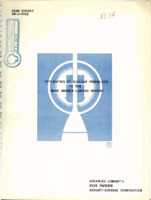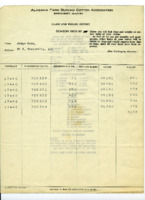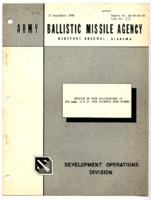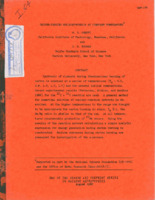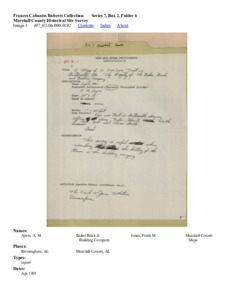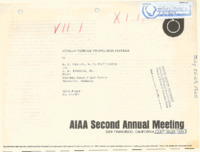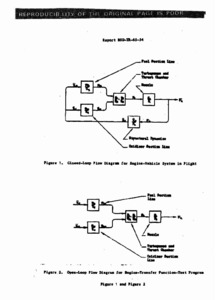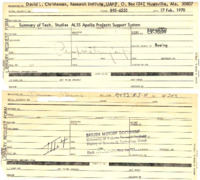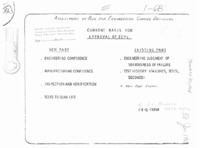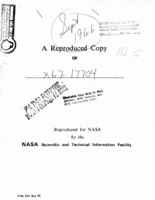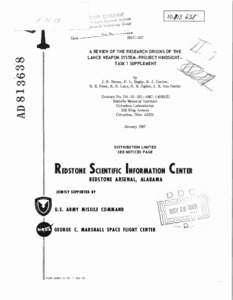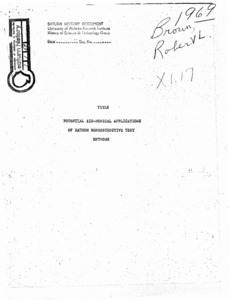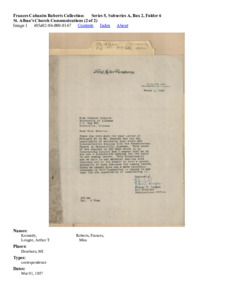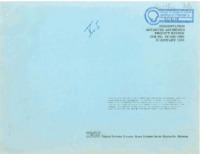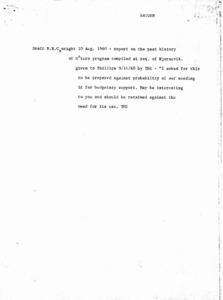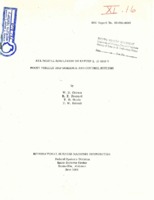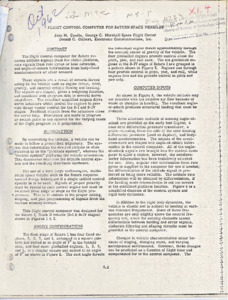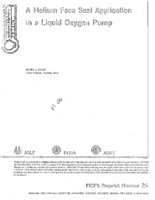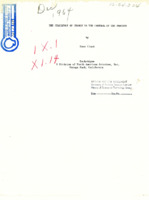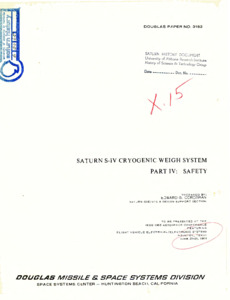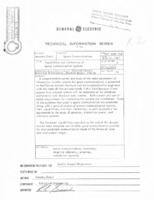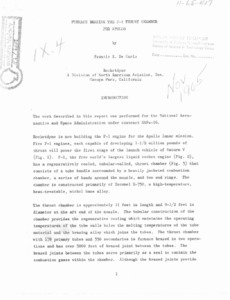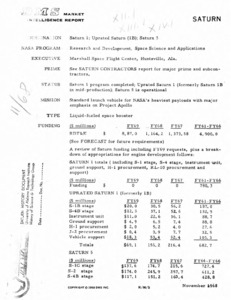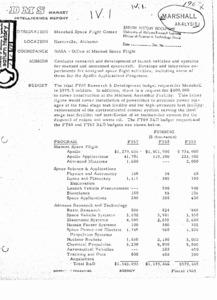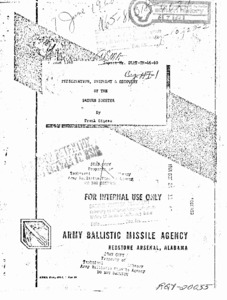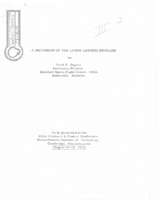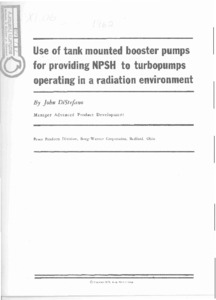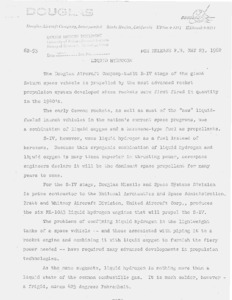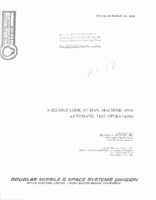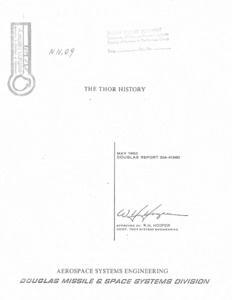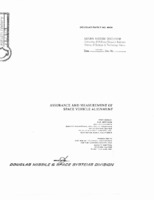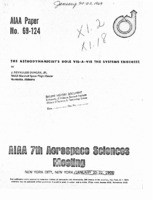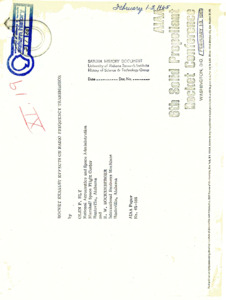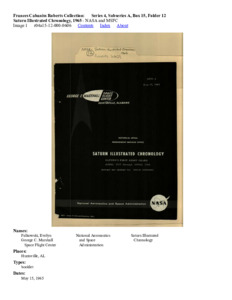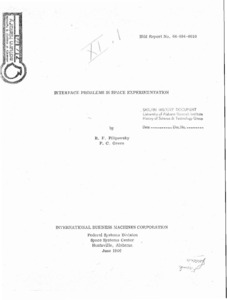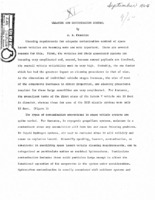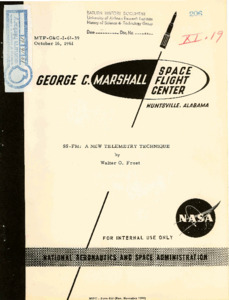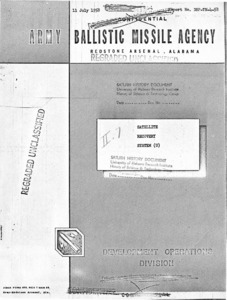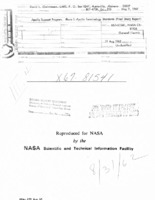
Browse Items (192 total)
Sort by:
-
"Application of Nuclear Propulsion to the Mars Manned Landing Mission."
This report has been prepared to provide Aerojet management and the interested NASA offices with nuclear propulsion decision aid data. The primary intent of these analyses is to evaluate potential space missions which may utilize nuclear propulsion in an effort to determine the most desirable characteristics of a nuclear propulsion system. -
Class and Weight Report.
This is the class and weight report for the Alabama Farm Bureau Cotton Association based on the 1929-1930 cotton season. -
"Carbon-Burning Nucleosynthesis at Constant Temperature."
"Carbon-Burning Nucleosyntesis at Constant Temperature" is part of the Orange Aid preprint Series in Nuclear Astrophysics, August 1968. The abstract states "Syntesis of elements during thermonuclear burning of carbon is examined at a series of temperatures (T=0.6, 0.8, 1.0, 1.2, 1.4) and for several initial compositions. Recent eperimental results (Ptterson, Winkler, and Zaidins 1968) for the 12C+!@C reaction are used. A general method for numerical solution of nuclear-reaction networkds is described. At the higher temperatures in the range now thought to be appropriate for carbon burning in stars, -
Marshall County Historical Site Survey
This section contains reports related to the Marshall County Historical Site Survey. The reports are centered around soil-maps and other maps related to traffic. -
"Apollo Vehicle Propulsion Systems."
This paper discusses the propulsion requirements for various stages of the Apollo vehicles and the development of these engines. -
"Pogo analysis of the Saturn Propulsion System."
Report that contians images of graphs, photographs and diagrams. -
"Apollo Logistics Support System (ALSS) Payloads Summary Report."
This report includes a summary of the major tasks performed by the Apollo Logistics Support System Payloads with an emphasis on the Lunar Mobile Laboratory (MOLAB). -
"Assessment of Risk for Engineering Change Decisions."
This document includes the current basis for approval of ECPs, fatigue life after stress reduction, and other probability and comparative risk assessments. On the first page there is an inscription, "By E.L. Bombara NASA-MSFC." -
"Application of the Saturn V Launch Vehicle to Unmanned Scientific Exploration of the Solar System."
According to the foreword, "This paper presents the results of a twelve-week mission and systems analysis of a combined Jupiter orbiter/solar probe mission utilizing the Saturn V launch vehicle." -
"A review of the research origins of the LANCE weapon system -- Project hindsight -- Task 1 supplement."
This report includes a discussion of 57 research and exploratory development events that have been identified as contributing significantly to LANCE. Forty-six of these are research events. Eight of the research events deal with LANCE aerodynamics, four with propulsion, 24 with solid-state components used in the guidance and control system,and 10 with the research origins of the materials and manufacturing processes used in LANCE. In addition, 11 exploratory development events are identified. The principal concern of this study has been the identification of further research origins of LANCE and the 46 documented events are its major product. A further concern and obligation of this study has been to provide HINDSIGHT with some additional data on the research phenomenon including some further observations on the nature and route of research utilization.; FOREWORD: The purpose of this report is to present a survey of fundamental research contributing to the successful development of the LANCE weapon system. Included in this report are discussions of research inputs to a number of LANCE systems and technology areas. The circumstances of these research contributions to LANCE are discussed. The implications of these examples of research utilization are analyzed and some general observations and conclusions on the research payoff phenomena are given. This report was requested by the Army Missile Command as a supplemental contribution to Project HINDSIGHT.; Contract No. DA-01-021-AMC-14693(Z).; Battle Memorial Institute ,Columbus Laboratories.; RSIC-627.; Includes letter from W. Metscher, Lt. Col. to Mr. David L. Christensen dated March 14, 1969. -
"The potential bio-medical applications of Saturn nondestructive test methods."
A brief history and purpose of nondestructive methods followed by a discussion of those methods. -
St. Alban's Church Communications (2 of 2)
Folder containing documents, correspondence, lists and photographs relating to St. Alban's Church in Gainesville, Alabama. -
Advanced Astrionics project review.
Given at the IRAD Technical Seminar, Gaithersburg, Maryland, January 30, 1968. F. L. Pugh, Principal investigator; E. C. Caldwell, Advanced IU Systems, IBM Huntsville. -
"Saturn: draft."
Report on the history of the Saturn program. -
"All Digital Simulation of Saturn I, IB, and V: Boost Vehicle and Guidance Control Systems."
The introduction notes, "The Saturn V launch vehicle is being developed by the National Aeronautics and Space Administration's George C. Marshall Space Flight Center for Project Apollo; Saturn I and Saturn IB vehicles are providing the early testing and support for Project Apollo. The nerve center of the Saturn is its guidance and control system. An airborne digital computer provides the link which closes both the guidance and control loops,making verification of the flight computer program of vital importance. During a powered flight this onboard digital computer program can be divided into four major parts:a) guidance, including navigation, b) control, c) vehicle sequencing, and d) computer telemetry." -
"Flight Control Computer for Saturn Space Vehicles."
The flight control computer for Saturn receives attitude signals from the stable platform, rate signals from rate gyros or lead networks, and angle-of-attack information from body-fixed accelerometers or other sensors. -
"A Helium Face Seal Application In a Liquid Oxygen Pump."
Presented at the Fourth International Conference on Fluid Sealing held in conjunction with the 24th annual meeting in Philadelphia, May 5-9, 1969. -
"The Challenge of Change vs the Control of the Process."
The introduction states, "This paper is designed to present the Rocketdyne engine program as it applies to the Saturn launch vehicles and will apply to the Apollo program of manned flight to the moon (Fig. 1). The vehicle that will launch this flight is the Saturn V, the largest and most powerful of the Saturn family. This vehicle, 362 feet tall and 33 feet in diameter, will be capable of sending a 45-ton payload to the moon or placing a 120-ton payload in earth orbit. Five F-1 engines power the first stage of the Saturn V; five J-2 engines, the second stage; and one J-2 engine, the third stage. The thrust of the first-stage engines alone will be equivalent to 160 million horsepower. Both of these engines, the F-1 and the J-2, were designed at, and are currently being produced by Rocketdyne." -
"Saturn S-IV cryogenic weigh system. Part IV : safety."
During cryogenic weigh system operation, hydrogen when combined with oxygen can create an unsafe condition. Therefore the concentration of the residual oxygen and hydrogen from leaks in the cryogenic weigh environmental bags must be known at all times during the cryogenic weigh. Hydrogen and oxygen detectors will provide the optimum method for maintaining safe conditions. Hydrogen properties and safe mixtures are reviewed. The method selected to analyze the oxygen content is discussed. The selection, development, and testing of a hydrogen detector system is examined. -
"Capabilities and Limitations of Space Communication Systems."
The paper "Capabilities and Limitations of Space Communication Systems" is part of a General Electric Technical Information Series prepared for the Apollo Support Department. The abstract states "A survey and study of the basic parameters of information transfer systems for space communications is presented in this paper, to familiarize systems checkout and on communication engineers with the state-of-the-art and trends in this field. Both current and anticipated requirements for space communication systems are briefly considered. Some of the problems that exist in space communication are presented, along with a general review of current communication systems, their capabilities, and limitations as well as possible improvements in the areas of spacecraft directional antennas, ground stations and antennas, spacecraft transmitter power, and telemetry systems. It is concluded that the increased capabilities expected by the end of this decade should make adequate and reliable space communication possible for most predicted communication needs of future space missions at lunar and near-planet ranges." -
"Furnace Brazing the F-1 Thrust Chamber for Apollo."
This work described in this report was performed for the National Aeronautics and Space Administration under contract NASw-16. Rocketdyne is now building the F-1 engine for the Apollo lunar mission. Five F-1 engines, each capable of developing 1-1/2 million pounds of thrust will power the first stage of the launch vehicle of Saturn V. -
"Saturn : DMS market intelligence report."
Lists numerous costs. -
"Marshall analysis : DMS Market Intelligence Report."
Lists numerous costs. -
Preservation, shipment & recovery of the Saturn booster.
The purpose of this report is to present the shipping and recovery procedures for the Saturn booster. -
"A Discussion of the Lunar Landing Problem."
Digesu worked in the Astrionics Division of MSFC. This paper was presented at the AIAA Guidance & Control Conference, Massachusetts Institute of Technology, Cambridge, Massachusetts, August 12-14, 1963. -
"Use of tank mounted booster pumps for providing NPSH to turbopumps operating in a radiation environment."
This paper outlines the results of a test program which was planned to demonstrate the feasibility of using a tank mounted, all-inducer, high speed liquid hydrogen booster pump to provide NPSH for the turbo pump in a reactor-powered vehicle. The cavitation problem associated with pumpoing liquid hydrogen, when used as a propellant, is further aggravated by localized heating caused by radiation from the reactor. -
"Liquid Hydrogen."
Review detailing the use of liquid hydrogen in Saturn rockets. -
"A Second Look at Man, Machine, and Automatic Test Operations."
A summary found following the errata page reads: "This paper presents a second look at the subject of the man-machine relationship in automatic test operations. 'Man, Machine, and Automatic Test Operations' was presented by the writer at Battelle Memorial Institute in November of 1963...It is the purpose of this second look at the man-machine interface to pinpoint those concepts which have proven their worth with time and those concepts which have proven to be weak, and as a result modified with time." This paper was prepared by George F. Meister, Jr. -
The History of Thor.
This history is intended as a quick orientation source and as a ready-reference for review of the Thor and its systems. The report briefly states the development of Thor, summarizes and chronicles Thor missile and booster launchings, provides illustrations and descriptions of the vehicle systems, relates their genealogy, explains some of the performance capabilities of the Thor and Thor-based vehicles used, and focuses attention to the exploration of space by Douglas Aircraft Company, Inc. -
"Assurance and Measurement of Space Vehicle Alignment."
Prepared by A. W. Dryden, Quality Engineer, Quality Engineering, Reliability Assurance, Space Systems Center, Douglas Aircraft Company, Inc., Huntington Beach, California. Presented to the 21st Annual Technical Conference for the American Society for Quality Control, Chicago, Illinois. 30 May to 2 June 1967. -
"Saturn Radar Altimeter."
Paper given at the AIAA Guidance and Control Conference, August 12-14, 1963, Massachusetts Institute of Technology, Cambridge, Massachusetts. -
"The Astrodynamicist's Role vis-a-vis the Systems Engineer."
By J. Reynolds Duncan, Jr., Aerospace Engineer, NASA Marshall Space Flight Center, Huntsville, Alabama. AIAA 7th Aerospace Sciences Meeting, New York City, New York, January 20 - 22, 1969. -
"Rocket exhaust effects on radio frequency transmission."
Presented by Olen P. Ely, National Aeronautics and Space Administration, Marshall Space Flight Center, Huntsville, Alabama and R. W. Hockenberger, International Business Machines. Paper that explores the effects of rocket-engine exhaust on radio-signals. -
Saturn Illustrated Chronology, 1965
NASA and MSFC -
"Interface Problems in Space Experimentation."
Space experimentation is expanding rapidly. Unmanned satellites are being equipped with precision instruments of greater power, and manned space stations accommodating large crews are in the drawing-board stage. The interface problems between these sophisticated instruments and between man, the spacecraft, and the supporting groundstations are multidimensional. This paper analyzes the scientific/technical areas of space experimentation, and continues with a review of the subsystems and support systems required to supply and operate the large variety of instruments. Areas of major integration efforts are singled out and the requirements for further developments and improvements are listed. A bibliography of 95 references is enclosed to assist in the identification of more detailed reports on all vital aspects of space experimentation.; Archive copy is a photocopy.; Supplement to IEEE Transactions on Aerospace and Electronic Systems, Vol. AES-2, No. 4, July, 1966. Pages 237 to 255. -
"Cleaning and Contamination Control."
The document is a paper describing contamination cleaning methods and advocating for further developments in the field. Tables and figures are included at the end of the paper. The figures include a comparison of Saturn V with Saturn I and Saturn IB and cross-sections of the Saturn C-5, S-IC stage fuel tank assembly and oxidizer tank assembly. -
"A new telemetry technique."
A technique new to telemetry is discussed which promises to alleviate an enigma facing the telemetry engineer : How to adequately transmit the avalanche of vibration and other wideband data desired in the development phase of large missiles and launch vehicles. The data channels are stacked in the frequency spectrum as single sideband subcarriers which frequency modulate the RF carrier. The system design utilizes to advantage the statistical properties of vibration data to achieve maximum data transmission efficiency from the available RF carrier deviation. However, in contrast to proposed statistical predigestion techniques, the data is transmitted in raw form. -
"Satellite recovery system."
Report focusing on the problems of the satalite recovery system and the possible solutions for those problems. -
Apollo Support Program: Phase 1: Apollo Terminology Standards Final Study Report.
From the abstract: "This report concludes the Phase 1 study activities of the requirements for terminology standardization of the Apollo Integration Support Program. A review is made of the studies conducted and the findings resulting from these activities. Conclusions are drawn and recommendations are made for a proposed Apollo Terminology Handbook. An implementation plan for producing and maintaining an Apollo Terminology Handbook is included. A sample of such a terminology handbook is produced as Part 2 of this report."
